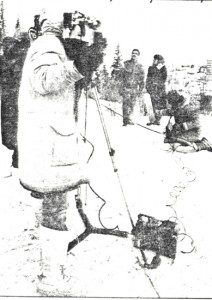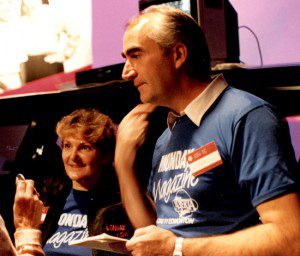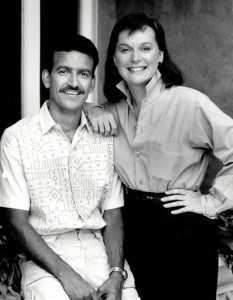
We had been sitting inside our TV crew van for about 15 or 20 minutes, waiting. We weren’t about to venture outside until things were ready for us. Meantime, my co-host – Lee Mackenzie – and I, rehearsed what we would say. We wanted to make sure, the moment our producer called for us to speak our lines in front of the camera, outside, that we could deliver the introduction to our TV show in one take (without any mistakes). Why? Well, our camera location was on a hill overlooking Fort McMurray, Alberta, in wintertime. The temperature outside our van that day was about –40. Eventually, all was ready and we dashed outside, took our spots, rolled the video and spoke our lines.
“Hi, I’m Lee Mackenzie,” she said.
“And I’m Ted Barris,” I said. “Welcome to ‘Monday Magazine’ from Fort McMurray…”
Now the tricky part was getting through the next minute or so doing a rundown of all the items in our show, a kind of teaser for what viewers would see on the show. (“Monday Magazine” was a half-hour current affairs/lifestyle TV show on CBC in Alberta for a couple of seasons in the mid-1980s. We did on-location stories about weird and wonderful people, events and places.)

So, we did our lines three times – once with the camera rolling on Lee; once on me; and finally rolling video of the two of us together. Amazingly, we did all three takes flawlessly. Anyway, after about five minutes outside, Lee and I couldn’t do one more take if we’d wanted to. Our mouths were just about frozen. The –40 essentially forced our producer to say those magic words:
“Take is good,” Mike Sutton shouted from between his chattering teeth. “Let’s get back inside and warm up.”
Now, I lived a long time in western Canada and it’s quite true what they say. A dry cold is a lot more tolerable than a damp cold, such as some of the bone-chilling days we’ve endured across Ontario this week. But even a dry cold in a stiff Fort McMurray breeze made it seem as if we’d decided to shoot our video at the North Pole. Come to think of it, Fort McMurray is located just below the 60th parallel. But that morning, trying not to flub our lines on camera, seemed like the coldest experience of my life.
But then, there were other occasions when I felt as if I were living in Inuvik and not southern Ontario. I can remember playing house-league hockey when I was six or seven years old. In those days, we lived in the village of Agincourt (now Scarborough, Ont.) and our Saturday morning games took place at the local arena. And, if ours was the first game of the day, it mean we had to help shovel snow off the ice before we played.
You’ve got the picture? We changed into our hockey gear indoors, but we played our games on outdoor ice – snow or shine. I can remember it, like yesterday. After a game when the temperature on the ice had been –10 or –15, each one of us kids ripped off our skates and began hopping around the dressing room screaming, wailing, wishing for that excruciating pain of our toes thawing to stop. I remember the first time our house-league team made it to the finals; the coach said the warmest words I think I’ve ever heard.
“We’re playing in the final,” he said, “indoors at the Ted Reeve Arena.” In our day, that was like being told we would play at Maple Leaf Gardens. Our toes wouldn’t freeze. Plus, we wouldn’t have to shovel the ice.
I remember getting pretty cold the day I led a tour group to the First World War memorial at Vimy Ridge on the 95th anniversary of the battle (in 2012). We walked to the monument, witnessed the hour-long ceremony, and returned to our tour bus – all in continuously pouring April rain. Given the knowledge, on an Easter morning in 1917, that nearly 100,000 Canadians had trudged up that ridge in even worse weather conditions, and with an enemy shooting back at them, nobody in our tour group complained about the downpour. But our faces said it all: “It’s bloody cold out here!”

By the way, I didn’t finish my Fort McMurray story. Later on that winter morning in 1985 – as was our on-location routine – one of our camera crew checked the videotape of the introductions we’d done on that frozen hilltop overlooking Fort McMurray. Well, you want to know how cold it was? It was so cold that one of the tubes in the camera (they had three primary colour tubes in cameras in those days)… one of tubes had seized up in the cold and every one of our takes had come out with only two of the three primary colours included. That meant we had to go back and shoot the entire intro all over again, on that frozen hillside.
The glamour of show business, eh?